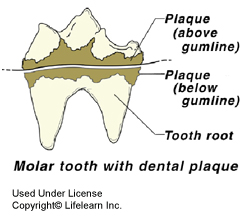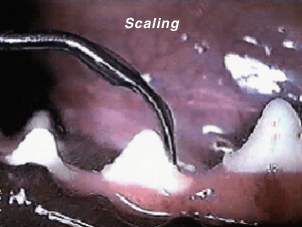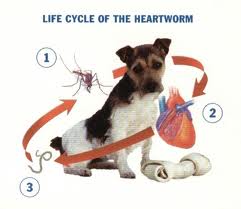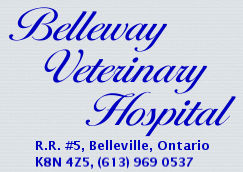| Dental Disease in Dogs | Dental Disease in Cats |
| Heartworms | Toxoplasmosis |
| Pets & Gardens |
Dental Disease in Dogs
I was unaware that dogs have dental problems. Is it common?
Dental disease is one of the most common medical conditions seen by veterinarians. Over 68% of all dogs over the age of three are estimated to have some form of periodontal or dental disease.
"Few pets show obvious signs of dental disease."
Few pets show obvious signs of dental disease. It is up to the pet's family and veterinarian to uncover this hidden and often painful condition.
Are dental problems the same in pets and people?
No. In man, the most common problem is tooth decay, which, due to the loss of calcium from the enamel, results in painful, infected caries (also called cavities). In the dog, tooth decay represents less than 10% of all dental problems. The most common dental problems seen in dogs are caused by periodontal disease.
What is periodontal disease?
Periodontal disease is a term used to describe inflammation or infection of the tissues surrounding the tooth. Accumulation of tartar and calculus on the teeth causes gum recession around the base of the tooth. Infection soon follows and the gums recede further, exposing sensitive unprotected tooth root surfaces and the bony tooth sockets Left untreated, the infection spreads deep into the tooth socket, destroying the bone. Ultimately, the tooth loosens and falls out.
Is periodontal disease very common?
It is estimated that more than two-thirds of dogs over three years of age suffer from some degree of periodontitis, making it by far the most common disease affecting our pet dogs.
How does tartar form and why is it a problem?

The mouth is home to thousands of bacteria. As these bacteria multiply on the surfaces of the tooth, they form an invisible layer called plaque or biofilm. Some of this plaque is removed naturally by the dog's tongue and chewing habits. If allowed to remain on the tooth surface, the plaque thickens and becomes mineralized. Mineralized plaque forms tartar and as the tartar thickens further it becomes calculus. The tartar accumulates above and below the gumline and presses on the gums, causing inflammation called gingivitis.
As the oral infection progresses, tonsillitis and pharyngitis can also occur. The bacteria can also be absorbed into the blood stream and be carried to other organs. "Bad teeth" can cause infections in the heart valves (endocarditis), kidneys and/or liver.
Can tartar be prevented?
Plaque becomes mineralized in some dogs much quicker than in others.
"The best way to prevent tartar build-up is regular home care, particularly tooth brushing..."
The best way to prevent tartar build-up is regular home care, particularly tooth brushing using toothpaste that is specifically designed to be swallowed. Special dog chew toys and treats may help reduce or delay tartar build-up. Some pet foods have been specifically formulated as dental diets that mechanically assist in plaque removal.
Will feeding dry food remove tartar?
Pet food manufacturers have recently developed new dental diets that can help reduce the formation of plaque and tartar in your pet. Once tartar has formed, it will be necessary to remove it by professional scaling and polishing under general anesthesia.
What is involved with a routine dental cleaning?
A routine dental cleaning involves a thorough dental examination, followed by a dental scaling and polishing to remove the tartar and invisible plaque from all of the tooth surfaces. Your veterinarian will perform pre-anesthetic blood tests to ensure that kidney and liver function are satisfactory for anesthesia. Sometimes antibiotic treatment is started before the periodontal therapy is performed. Your veterinarian will discuss the specific pre-dental recommendations for your pet.

Once your dog is anesthetized, your veterinarian will thoroughly examine the mouth, noting the alignment of the teeth and the extent of tartar accumulation both above and below the gumline. If periodontal disease is severe, it may not be possible to save badly affected teeth, which may need to be extracted. Next, tooth scaling will be performed using both traditional hand scalers and ultrasonic cleaning equipment to remove all traces of tartar, both above and below the gum line. The tartar below the gum line causes the most significant gum recession and it is extremely important that it is removed thoroughly. After scaling, the teeth are polished to remove microscopic scratches in order to help prevent subsequent plaque build-up. Special applications such as fluoride, antibiotic preparations and cleaning compounds may be indicated to decrease tooth sensitivity, strengthen enamel, treat bacterial infection and reduce future plaque accumulation.
The procedures that your pet may require will be discussed with you before your pet's dental cleaning. Since it can be difficult to predict the extent of dental disease in advance of the procedure, it is imperative that your veterinarian is able to reach you during the procedure to discuss any additional treatment that may be necessary.
Why can't I just remove the tartar and plaque with a dental scaler?
Although you can remove the tartar that has accumulated above the gumline in some dogs that are extremely co-operative, there are three problems with doing this. First, only the tartar above the gumline is removed, leaving behind the material below the gumline, which will continue to cause periodontal problems. Second, it is not possible or safe to clean the inner surfaces of the teeth properly in a conscious dog. Third, the use of any instrument on the tooth enamel will cause microscopic scratches on the surface, ultimately damaging the tooth surface and leading to further disease. (This is the reason why your dental hygienist always polishes your teeth after removing the tartar with dental instruments).
Do I have to make an appointment for my dog to have a dental scaling and polishing?
Yes. Your veterinarian will perform pre-anesthetic blood tests, examine your pet for any other underlying disorders prior to the procedure, and determine if antibiotic treatment should be started in advance.
How can I prevent tartar accumulation after the procedure?

"Plaque and tartar begin forming in as little as six hours after your pet's dental cleaning."
Plaque and tartar begin forming in as little as six hours after your pet's dental cleaning. A home dental care program including regular tooth brushing is a must for all pets. Your veterinarian will provide you with detailed instructions on how to brush or rinse your pet's teeth
Can I use human toothpaste?
Absolutely not. Human dentifrice or toothpaste should never be used in dogs. Many human toothpastes and other oral hygiene products contain xylitol, a sugar substitute that is safe for use in humans but highly toxic in dogs (for further information, see our handout "Xylitol Toxicity in Dogs").
Even if there is no xylitol in the toothpaste, these foaming products contain ingredients that are not intended to be swallowed and that could cause internal problems if they are swallowed. Human products often contain higher levels of sodium than your pet requires, which is another reason why they should not be swallowed.
You should also avoid using baking soda to cleang your dog's teeth. Baking soda is alkaline and if swallowed can upset the acid balance in the stomach and digestive tract. In addition, baking soda does not taste very good, and may cause your dog to be uncooperative when you try to brush its teeth.
Why is pet toothpaste recommended?
Numerous pet toothpastes that are non-foaming and safe to be swallowed are available in flavors that are appealing to dogs; depending on the brand, you may be able to find flavors such as poultry, beef, malt or mint. If you use a product that tastes good, your pet will be more likely to enjoy the whole experience. In addition to the pleasant taste, many of these doggy toothpastes contain enzymes that are designed to help break down plaque chemically, thus reducing the time you need to spend actually brushing your dog's teeth.
Dental Disease in Cats
How common is dental disease in cats?
Dental disease is one of the most common medical conditions seen by veterinarians. Approximately two-thirds of cats over three years of age have some degree of dental disease. The most common problems are due to periodontal disease, gingivitis and cervical neck lesions, also called oral resorptive lesions.
What are the clinical signs of dental disease?
Certain signs should alert you to the presence of dental disease or other oral problems in your cat. Your cat may show a decreased interest in food or approach the food bowl and then show a reluctance to eat. It may chew with obvious discomfort, drop food from the mouth, or swallow with difficulty. The cat may drool excessively, and the saliva may contain blood. The cat may have halitosis, or an unpleasant breath odor. In some cases, cats may paw at their mouths or shake their heads. A reluctance to eat may lead to weight loss, which can become quite marked. Many cats will refuse dry food and demonstrate a preference for moist or canned foods. Dental disease and oral pain may account for the "finicky appetites" that some cats display.

What causes dental disease?
The most common cause of dental disease in cats is tartar and calculus accumulation on the teeth. The tooth surfaces are a home to thousands of bacteria that multiply and produce a layer of plaque. Some of this plaque is naturally removed during eating or by the action of the cat's tongue. However, the remaining plaque quickly mineralizes, forming tartar and calculus. The bacterial products and decaying food stuck to tartar are one potential cause of bad breath.
Tartar is easily identified by its tan or brown color. It normally starts at the gum edge, especially on the back teeth called the premolars and molars. In severe cases, tartar and calculus may cover the entire tooth.
"If gingivitis is allowed to persist untreated, then irreversible periodontal disease will occur."
The accumulation of tartar and bacteria on the tooth surfaces leads to infection and gingivitis or inflammation of the gums. If the disease is caught at an early stage and a thorough veterinary dental scaling and polishing performed, most of the teeth and gums will have a full recovery. However, if gingivitis is allowed to persist untreated, then irreversible periodontal disease will occur. Periodontal disease is an inflammation or infection of the bone and ligaments that support the tooth; as it progresses these tissues are destroyed, leading to excessive tooth mobility and eventual tooth loss. Bacteria can spread deep into the tooth socket creating an abscess or even more severe problems such as osteomyelitis.
Once periodontal disease starts the degenerative changes to the tooth and its support structures cannot be reversed. These changes make it easier for more plaque and tartar to collect, resulting in further disease.
Is gingivitis always associated with dental disease?
A slight degree of redness seen as a thin line along the edge of the gum may be normal in some kittens and adult cats with no evidence of dental disease.
Some cats develop severe gingivitis with minimal signs of accompanying dental disease. The affected areas may extend beyond the gums to other areas of the mouth, such as the throat or tongue. The cause of this condition is poorly understood, but it is likely to be multi-factorial and may differ between individual cases. This condition is often very difficult to control and may require repeated or constant treatment, and its accurate diagnosis can involve extensive investigative procedures.
What are cervical neck lesions?
"These lesions are intensely painful, and the only effective and humane treatment is to extract the tooth."

Cervical neck lesions result from a progressive destruction of the enamel resulting in slowly deepening "holes" (cavities or caries) in affected teeth. Once the sensitive parts of the tooth are exposed, these lesions are intensely painful, and the only effective and humane treatment is to extract the tooth. The cause of this disease is unknown; however, poor oral hygiene may play a role in the disease process.
What should I do if my cat has signs of dental problems?
If you see that your cat has evidence of tartar accumulation, gingivitis or is exhibiting any signs of mouth pain or discomfort, you should take it to your veterinarian for an examination. You will be advised of the most appropriate course of treatment, which may involve having the cat's teeth examined and professionally cleaned under general anesthesia.
The rate of tartar accumulation is very variable between individual cats, and in some cases, this may necessitate professional cleaning on a regular basis such as every six to twelve months.
Do not try to remove tartar from the teeth yourself using any form of metallic instrument. Aside from potentially harming your cat's mouth or the cat harming you, you will damage the tooth surface by creating microscopic scratches; these will provide areas for bacteria to cling to and encourage more rapid plaque formation, thus making the problem worse. (This is the reason why your dental hygienist always polishes your teeth after removing the tartar with dental instruments).
What can I do to help prevent dental disease in my cat?
The best way prevent dental disease is to keep the mouth as hygienic as possible and to reduce the rate at which tartar builds up on the teeth.
Recent advances in pet nutrition have resulted in diets that reduce tartar accumulation. Your veterinarian can give you specific dietary recommendations that will benefit your cat's dental health.
"With gentleness, patience and perseverance it is possible to brush some cats' teeth."
However, the most effective way of reducing plaque and tartar is to brush the teeth. A number of toothbrushes are specially designed for a cat's mouth. Never use human toothpaste on cats. These are foaming products and contain ingredients that should not be swallowed and could cause internal problems. Numerous pet toothpastes that are non-foaming and safe to be swallowed are available in flavors that are appealing to cats. With gentleness, patience and perseverance it is possible to brush some cats' teeth.
In addition, or as an alternative to brushing, a range of antibacterial mouthwashes and gels can be applied to the teeth and mouth to reduce the number of bacteria present. Please ask your veterinarian for further details regarding the recommended dental products for your cat.

It's Heartworm Season!
Heartworm is a serious and potentially fatal condition caused by parasitic worms that live in the heart and blood vessels that supply blood to the lungs of infected animals.
Pets can contract heartworm disease from mosquitoes that are infected with heartworm parasites. When an infected mosquito bites an uninfected dog, it injects the immature worms into the tissue of the animal through its saliva.
Once injected, the immature worms develop, migrating to the lungs and potentially the heart, where they mature into adults and begin to reproduce. These worms can grow to a length of 15-30 centimeters, and in severe cases a dog may be infested with hundreds of worms. Mature worms produce thousands of larvae that can then be spread to other dogs or cats by mosquitoes.
The infestation can result in damage to the heart, lungs and liver. The pet may die as a result of severe damage to the internal organs.
Heartworm is a disease that poses a serious threat to pets in Canada and the United States, and especially to dogs. The good news is that it can be easily prevented through regular testing and the use of preventive medication.
What happens if my pet tests positive for Heartworm?
Treatment for heartworm disease is available, but it is costly and is not without dangers. Treatment involves a series of injections to kill the adult worms, and then a treatment to kill the immature worms in the bloodstream.
Prevention is the key!
Heartworm can be easily prevented in Ontario. Your veterinarian will begin by taking a sample of your dog's blood, sending it to a lab where they look for the presence of adult parasites. Ideally this test should be done yearly. If your dog is not infected a preventive program should be started. The preventive program involves giving the dog a pill or applying a solution to the skin once a month during mosquito season, which (in Ontario) typically runs from June to November. This medication destroys the immature heartworms transmitted by the mosquitoes and stops the cycle of the parasites.
With the safe and affordable heartworm preventives available today, no pet should ever have to endure this dreaded disease and most heartworm preventatives include flea prevention!

Pets and Gardens
We share our homes, including our outdoor spaces, with our animal companions. At times, our pets have a different idea of what constitutes acceptable behavior than we do. Two of the more common problems that face property owners include how to cope with pets that dig and how to minimize the damage from pets that relieve themselves on the lawn or bushes. Both of these activities are natural in most pets, and thus are very difficult to eliminate. Therefor, we have to come up with compromises that will please both pet and property owner.
One relatively effective way of curtailing digging in flowerbeds is to lay chicken wire or a similar product just below the surface of newly dug flower or vegetable beds. The plants will be able to come up through the holes but the pet will not enjoy getting his or her paws stuck in the wire. The material can be covered with a light layer of concealing mulch for aesthetics. Another solution is to provide your pet with a more appealing area in which to dig.
Creative solutions such as providing a doggy sandbox are often successful, especially if toys and other treats are other treats are buried at various depths in the sand. Sandbox sand is the ideal material to use for this purpose since it drains rapidly after a rainfall. If you set up a doggy sandbox, you will need to show your pet that it is okay to dig in this spot, while teaching him or her that it is not acceptable to dig elsewhere. Please call or email us if you would like specific and individualized advice about how to do this.
Cats that insist on using flowerbeds as outdoor litter boxes may also be deterred by the use of chicken wire, or may adapt readily to their own outdoor sandbox. Pet repellants may or may not be helpful, and some of them can be harmful to pets. If you choose to try a pet repellant product, make sure you read the label carefully.
Brown spots on lawns may appear where pets urinate frequently. Although urine is very concentrated, a single ‘deposit' usually doesn't destroy grass or leaves. However, dogs often prefer to urinate in the same general area, and passing dogs will usually mark the same spots with their urine, signaling their visit to the resident dog. To minimize damage to the lawn, ‘spot watering' on a frequent basis will dilute the urine and may be helpful. Edible products that purport to change the pH of pet urine do not tend to produce consistent results.
If you have a new dog, your best solution is to train him or her to eliminate in one specific place on the property. With patience and a little effort, you and your pets should be able to share the yard together.

Toxoplasmosis
Toxoplasmosis is a parasitic infection that infects mammals, including humans. It is caused by an organism called Toxoplasma gondii . A human can become infected with the organism through one of three ways: eating undercooked meat that contains toxoplasma cysts, accidentally eating infective toxoplasma ‘oocysts' or eggs, or transmission across the uterus from a pregnant woman into her unborn baby. In a healthy adult, infection poses very little risk. Infection during pregnancy may result in miscarriage or congenital birth defects. In an attempt to lower the risk, a pregnant woman may decide to give her cat away, which may not be necessary or appropriate.
Susceptible cats become infected with toxoplasma organisms by eating contaminated raw meat, including mice, or by eating contaminated soil. After an incubation period up to 5 days, the cat will excrete infectious oocysts in the feces, for a period of up to two weeks. Once exposed, the cat will usually become immune to re-infection. In order for a human to get toxoplasmosis from their cat, several things must happen:
- The cat must consume contaminated raw meat, either by hunting prey or through a raw meat diet that is contaminated with toxoplasma cysts
- The cat must have been exposed to the infected source within the previous few weeks, and have not been exposed in the past
- The infected oocysts in the feces must have had a chance to incubate to the infectious stage
- The human must ingest the infected oocysts, usually by touching the feces and then touching the mouth
It follows that, to avoid getting an infection from your cat, don't permit it to eat raw meat and clean out the litter box on a daily basis. For additional peace of mind, wear rubber gloves when cleaning the litter box, wash your hands thoroughly, and if pregnant, delegate the litter box duties to another family member.
If you are concerned, there is a specific blood test that can check for toxoplasma blood titers, and which will indicate whether or not you have been exposed to the organism in the past. Once exposed, people usually are immune to re-infection. Thus, a woman who has a toxoplasma titer will not pose any risk to her future offspring. In order to pass the infection to a fetus in utero, the pregnant woman must be exposed to toxoplasma for the first time during pregnancy.
In actual fact, toxoplasmosis is more likely to be acquired from eating infected undercooked meat or other contaminated food products. To minimize these risks, pregnant women should:
- Use good hygiene when handling raw meats or other food products, including disinfecting all cutting boards and utensils
- Wear gloves when working in the garden
- Wash hands frequently and thoroughly, especially after handling food or garden soil
Getting rid of your feline companion is not a necessary precaution. While it is possible for cats to transmit toxoplasmosis, the risk of your feline friend passing the disease to you is low, and your cat can continue to be a beloved part of your growing family.



